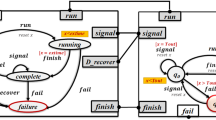Abstract
Attempts to engineer autonomic multi-agent systems, particularly those having large numbers of agents, have revealed the need for design structures and formalisms to support the construction of properties that emerge at the system level. Such emergence, like self-∗ behaviour, relies typically on intricate inter-agent interactions. This paper shows how the top-down incremental approach of Formal Methods can be used satisfactorily in that situation, by considering a case study in which agents adapt and autonomously achieve a given configuration.
Preview
Unable to display preview. Download preview PDF.
Similar content being viewed by others
References
Bedau, M.A.: Weak emergence. In: Tomberlain, J. (ed.) Philosophical Perspectives: Mind, Causation, and World, vol. 11, pp. 375–399. Blackwell Publishers, Malden (1997)
Burns, A., Hayes, I.J., Baxter, G., Fidge, C.J.: Modelling temporal behaviour in complex socio-technical systems. Technical Report YCS 390, University of York (2005)
Cucker, F., Smale, S.: On the mathematics of emergence. Japanese Journal of Mathematics 2, 197–227 (2007)
Derrick, J., Boiten, E.: Refinement in Z and Object-Z: Foundations and Advanced Applications. Springer, Heidelberg (2001)
Edmonds, B., Bryson, J.: The insufficiency of formal design methods — the necessity of an experimental approach for the understanding and control of complex MAS. In: International Joint Conference on Autonomous Agents and Multiagent Systems (AAMAS 2004), pp. 938–945. IEEE Computer Society, Los Alamitos (2004)
Hamann, H., Wörn, H.: A framework of space-time continuous models for algorithm design in swarm robotics. Swarm Intelligence 2, 209–239 (2008)
Henzinger, T.A., Qadeer, S., Rajamani, S.K.: Assume-guarantee refinement between different time scales. In: Halbwachs, N., Peled, D.A. (eds.) CAV 1999. LNCS, vol. 1633, pp. 208–221. Springer, Heidelberg (1999)
Jun, H., Liu, Z., Reed, G.M., Sanders, J.W.: Ensemble engineering and emergence. In: Wirsing, M., Banâtre, J.-P., Hölzl, M., Rauschmayer, A. (eds.) Challenges for Software-Intensive Systems and New Computing Paradigms. LNCS, vol. 5380, pp. 162–178. Springer, Heidelberg (2008)
Sanders, J.W., Smith, G.: Formal ensemble engineering. In: Wirsing, M., Banâtre, J.-P., Hölzl, M., Rauschmayer, A. (eds.) Challenges for Software-Intensive Systems and New Computing Paradigms. LNCS, vol. 5380, pp. 132–138. Springer, Heidelberg (2008)
Stepney, S., Polack, F., Turner, H.: Engineering emergence. In: IEEE International Conference on Engineering of Complex Computer Systems (ICECCS 2006), pp. 89–97. IEEE Computer Society, Los Alamitos (2006)
Støy, K.: Controlling self-configuration using cellular automata and gradients. In: 8th International Conference on Intelligent Autonomous Systems (IAS-8) (2006)
Støy, K.: Using cellular automata and gradients to control self-reconfiguration. Robotics and Autonomous Systems 54, 135–141 (2006)
Støy, K., Nagpal, R.: Self-reconfiguration using directed growth. In: 7th International Symposium on Distributed Autonomous Robotic Systems (DARS), pp. 149–160. ACM Press, New York (2004)
Støy, K., Nagpal, R.: Self-repair through scale independent self-reconfiguration. In: 2004 IEEE/RSJ International Conference on Intelligent Robots and Systems, pp. 2062–2067. IEEE Press, Los Alamitos (2004)
Wegner, P.: Why interaction is more powerful than algorithms. Communications of the ACM 40(5), 80–91 (1997)
Winfield, A., Liu, W., Nembrini, J., Martinoli, A.: Modelling a wireless connected swarm of mobile robots. Swarm Intelligence 2, 241–266 (2008)
Zambonelli, F., Omicini, A.: Challenges and research directions in agent-oriented software engineering. Autonomous Agents and Multi-Agent Systems 9(3), 253–283 (2004)
Zhu, H.: Formal reasoning about emergent behaviour in MAS. In: International Conference on Software Engineering and Knowledge Engineering (SEKE 2005). Knowledge Systems Institute (2005)
Author information
Authors and Affiliations
Editor information
Editors and Affiliations
Rights and permissions
Copyright information
© 2009 Springer-Verlag Berlin Heidelberg
About this paper
Cite this paper
Smith, G., Sanders, J.W. (2009). Formal Development of Self-organising Systems. In: González Nieto, J., Reif, W., Wang, G., Indulska, J. (eds) Autonomic and Trusted Computing. ATC 2009. Lecture Notes in Computer Science, vol 5586. Springer, Berlin, Heidelberg. https://doi.org/10.1007/978-3-642-02704-8_8
Download citation
DOI: https://doi.org/10.1007/978-3-642-02704-8_8
Publisher Name: Springer, Berlin, Heidelberg
Print ISBN: 978-3-642-02703-1
Online ISBN: 978-3-642-02704-8
eBook Packages: Computer ScienceComputer Science (R0)




